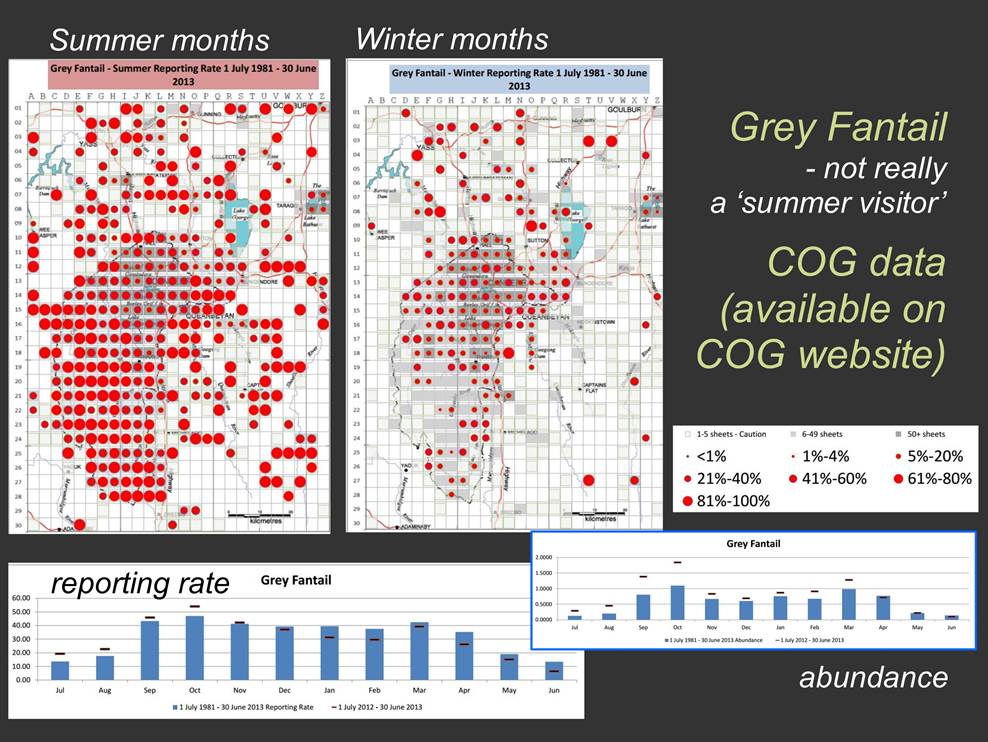Well I am surprised by that old quote from Stephen Marchant. It is certainly not a summer visitor now. He is regarded as being a stickler
for accuracy. Have things changed so much? Or was that just based on a limited survey (of the high country maybe)?
The GBS Report has:
Grey Fantail Rhipidura fuliginosa
This species is a common inhabitant of woodland and forest. It is conspicuous in its behaviour and voice and will readily approach and flutter around people. Sometimes they even appear to follow people. The occurrence
pattern shows an interesting similarity to the Willie Wagtail but is more marked. From a low in November and December rises smoothly to a peak in March, then declines through winter with a minor second peak in September and October. This shows the two periods
of partial migration through Canberra and the low numbers whilst breeding. Long-term there has been a fairly even increase in abundance. This has occurred in both the highs and lows of the monthly pattern. Breeding records are some nest building from October,
though mostly of dependent young from January to early March. Most breeding records are one-off observations, one had nest with eggs to dependent young over four weeks (Year 21 at Site 230).
Graphs on page: 102, Rank: 20, Breeding Rank: 30, A = 0.35350, F = 82.61%, W = 51.9, R = 22.954%, G = 1.54.
So the GBS results are close to the little abundance graph Geoff provided and also reasonably close to the recording rate graph. Although the latter shows less of a dip in summer. That is because that samples
a wider range of habitats and places and is less influenced by changes in abundance.
Philip
From: Geoffrey Dabb [
Sent: Wednesday, 13 April, 2016 12:20 PM
To:
Subject: FW: [canberrabirds] The mysterious G Fantail
Nicki may be correct in using ‘summer migrants’ for relocating G Fantails, but their movements seem to be variable. There is a traditional view among older Canberrathologists that the G Fantail is a summer visitor
eg Stephen Marchant re his 1964-1968 surveys:
“summer visitor. First arrival 10 September 1966”.
The current labelling on the COG website is the more accurate -
‘Common breeding resident. Much of the population of the ranges migrates in winter. Together with some from the tablelands.’ That is taken from Steve Wilson’s book. That book uses ‘tablelands’ a lot, the meaning
of which is not entirely clear. It seems to be all of the ACT, and possibly a more extensive area, that is not ‘the ranges’. The COG website (below) and the BLA atlas show a marked thinning out of the local GF population in winter, the atlas showing a corresponding
thickening in north Queensland.
Nonetheless, quite a few remain here in winter. Evidence of this is their frequent presence in the mixed feeding flock, largely an autumn/winter phenomenon. Where they are locally in the non-breeding months
must surely be determined by food (small flying insects) and hence rainfall, consequently variable year to year. Best spots are perhaps the denser vegetation on Mount Mugga and Black Mountain – and in particular the lush green tangles along the Molonglo
and other local watercourses.
This is not intended to overlook the sometimes spectacular ‘move through’ of large numbers of this species. Barbara Allan has just mentioned to me a morning when 500 GFs were in view at her spot on the Pinnacle,
only to be gone an hour later. Large numbers of transients are certainly around at the moment.

From: Nicki Taws [
Sent: Wednesday, 13 April 2016 7:12 AM
To:
Subject: [canberrabirds] K2C bird surveys 10 April
At the same time, late-departing summer migrants were still enjoying the warm days including
Dusky Woodswallow (up to 40 at two of sites), Grey Fantail, Black-faced Cuckoo-shrike and
Rufous Songlark skulking quietly in the grasslands.
Nicki Taws
0408 210736

